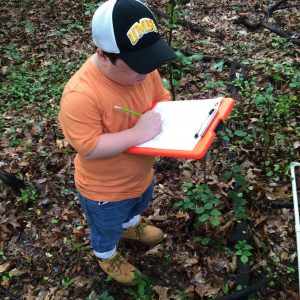What happens when Baltimore Green Space, UMBC and the U.S. Forest Service team up to put researchers in Baltimore’s neighborhood forest patches? Only good things – and nobody even got poison ivy! Right now the woods are dormant…enjoy this throwback to our summer.
This past summer we surveyed ten community forest patches with the goal of providing members of our Forest Stewardship Network with practical information about their community forest patches. “It’s hard to show how nice the urban forests are when you don’t know what’s there,” explains one of the three field researchers, Laura Templeton, who has a master’s degree in Forest Ecology from U-Md College Park. The other two field researchers, Alyssa Wellman-Houde and Josh Denicoff, are both undergraduates in Environmental Science at UMBC. Their research followed a protocol created by Baltimore Green Space, the U.S. Forest Service, and a scientist from UMBC.
In the summer heat, the researchers hauled surveying and sampling equipment through acres of Baltimore forest patches, drawing on their botany skills, experience with GIS and databases, and Laura’s knowledge of field research. To get an accurate inventory of the patches, they spent 192 hours in the field and 96 hours in the lab. “After all this time spent in field and lab,” wrote Josh, “we truly feel like scientists!”
The researchers were impressed that native trees made up most of the trees in the patches, rather than trees imported from other places. Native species are desirable because they are adapted to their place in the ecosystem in a balance that allows other plants to live in the same space. Laura and Alyssa mentioned that Norway Maples are an imported species that in the past were used as a street tree because they grow tall quickly, but when grown in a forest patch, it leafs out before native species and deprives the native plants of light. The crew was pleased to discover an unexpected diversity of oak species and to be able to document this good news, which, Alyssa says, “you wouldn’t necessarily know just looking at it from a distance.” In nearly all the patches, at least 80% of the trees counted were native.

Josh noted the heavy tools needed to take soil samples – and that “you’ll be ripped by the end of the summer!” The soil samples were both time consuming to collect and process, but worth it. The hours in the lab processing samples show that the bulk density of the forest soils was comparable to that in rural forests. This means that the forest floor is not compacted, so an urban forest will likely absorb rain just as well as a rural forest.
In less good news, the study revealed a lot of ground cover from invasive species like English ivy, which overwhelms native species.
Knowing the good, the bad, and the ugly about the forest patches is useful information for Baltimore Green Space. The data about the wide variety of native species show what to protect, while the data about the invasive ground cover species will give community forest patch stewards a direction for their work. The research enabled them to produce maps for community members showing location and distribution of both native and invasive species, among other things. As Laura said, “If it were all invasive, that’s demotivating, why bother? But you have a variety of native species, giving habitat to birds and animals, and you know what you need to protect.” Alyssa went on to explain that “the oaks were a nice surprise because they grow slowly. Juvenile oaks are more tolerant of shade than mature oaks. If you’re only seeing saplings and not older trees, it’s a sign they’re being crowded out. If you’re not seeing saplings, it might be a deer issue.” All of the data helps to tell a story about what is happening at the patch.

The summer researchers were not alone in their adventures. Though they knew forest stewards had endorsed the project, they were inspired by the enthusiasm that greeted them. The forest stewards and other neighbors offered help and expressed interest and excitement about the project, and shared their personal anecdotes about growing up in these natural places. This highlighted why the project matters, and gave more insight into how the forest patches touch the lives of individuals in the neighborhood. The community members were definitely glad to see the researchers. As Laura explained, “Seeing outsiders being interested is a morale-builder for neighborhood people, who love these forests and feel good that experts are coming in to help improve these assets.” Alyssa felt that the project made neighbors “feel pride that their forest was important enough to study.” Josh noted the dedication of the forest stewards who “take care of the forests by themselves and invest their own money and time into clearing poison ivy and vines to make the forests open to neighborhood.”
In all, the study’s results will help Baltimore Green Space assist forest stewards in caring for patches and bolster our claim that urban forest patches are environmentally significant. The results will help answer more questions such as: do the patches cool the air, do they reduce storm water run-off, provide habitat, and do they have social value? We’re very grateful to the team for their hard work and dedication!
Be the first to hear about exciting events, news, and opportunities.
[email protected]
(813) 530-8166
2100 Liberty Heights Avenue
Baltimore MD 21217
Facebook | Instagram | Twitter